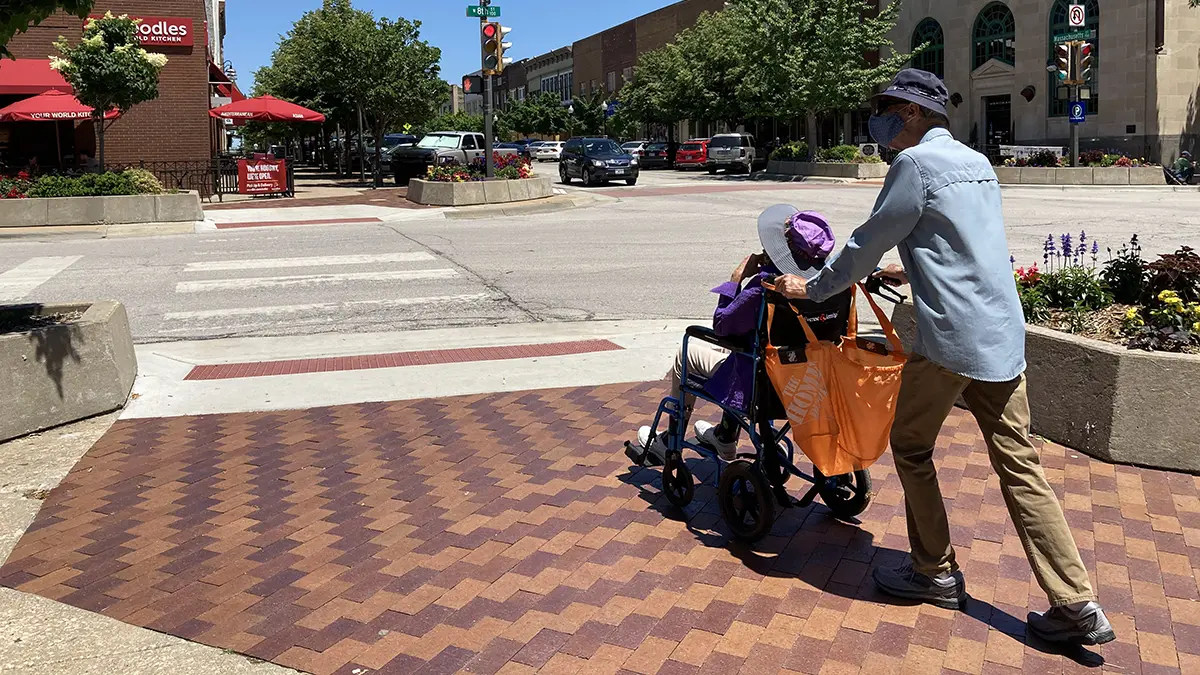Lawrence is proud of their bricks – You’ll see them displayed in storefront windows downtown, lining sidewalks and streets, as decorations in landscaping beds, and as mementos kept on bookshelves and desks. The Lawrence Vitrified Brick Company supplied our city with an influx of bricks in the late 1800’s – early 1900’s which are still around today.
We are fortunate to have such a rich history, which you can see in the brick paths we walk and brick streets we drive on. However, these bricks streets and sidewalks are seen in various conditions and styles – some in better shape and more accessible than others. This is, in part, because up to this point, we have not had a city-wide policy to provide guidance or standards on how to maintain, preserve, or design these pieces of key public infrastructure.
History
There have been multiple efforts over the last 10+ years to draft a brick streets and/or brick sidewalks policy. However, these past efforts have yet to be comprehensive in their approach to this complex topic; therefore, they have not been adopted.
In 2013, an effort spearheaded by the Public Works department reviewed the streets in Lawrence and determined the “pavement condition index” (PCI) of each street in town. Through this, they attempted to determine which brick streets should be prioritized for maintenance versus reconstruction or restoration. The engineers met with neighbors and discussed their findings and began to develop a proposal that outlined paving residential streets oriented east-west and reconstructing some north-south streets with brick. Sidewalks were explicitly not considered in this policy. This policy was brought before the City Commission and was not adopted; rather, the City Commission directed staff to rework the policy with additional community feedback and receive a recommendation of approval from the Historic Resources Commission (HRC). From these discussions with HRC there was interest in reviewing each street individually for its historic nature rather than relying on the “east-west model”. Staff began to rework the policy from these discussions and then it appears other projects were prioritized over the brick policy and progress stalled.
In 2019, city engineers began to craft a new policy for how brick streets would be maintained and restored. This policy development process focused on getting feedback from the neighborhoods with the highest number of brick streets: East Lawrence, Old West Lawrence, Pinckney, and Oread. These neighbors took to this process & crafted their own policy, which set a number of priorities and highlighted their interest in protecting the aesthetic and historic nature of brick streets, curbs, hitching posts and sidewalks in the “original town site.”
Some of the key components of this effort included interest in uncovering all brick streets that were previously overlayed with asphalt, training persons in the art of brick laying, and guidance on brick handling and storage. This policy was drafted by neighbors for their neighborhood and given to the Municipal Services Department with the belief that it would be reviewed by city staff and adopted by the City Commission. However, due to staff turnover, the pandemic, and lack of attainable and practical implementation strategies, this policy was tabled.
Both previous draft policies provide good background and include many lessons we can use moving forward with the new policy drafting process. In order for this policy to be successful, it must be built around our community’s values and feedback – which means listening to all members of our community, including those with mobility challenges, from all areas of our city. This policy also needs to be grounded in engineering standards, asset management, accessibility best practices, and attainable implementation strategies.
We have the opportunity in this new policy development process to honor those past efforts and the lessons learned by engaging in a better public process that focuses on implementation of the policy and provides standards for preservation, accessibility, and maintenance that have yet to be included in previous policy iterations.
What’s happening now?
The Transportation Planning Division within Municipal Services and Operations is leading a community feedback driven process to draft and propose a set of standards for brick streets and brick sidewalks.
This process recently kicked off with a subcommittee of key stakeholders from our community (Various Neighborhood Groups, KU, Independence Inc, LiveWell, and Historic Resources Commission) and a team of City staff who are providing that subcommittee with support and technical assistance. Together they determined a values-survey would be the best strategy to hear from the community at-large about how we should prioritize the conflicting values that are apparent in this policy discussion.
From this survey work, we discovered that safety was the top priority for both brick sidewalks and brick streets. Additional information on the surveys can be found here. The subcommittee will take this survey data, along with the aspirations and goals set forth by the neighborhood advocacy group in 2019-2021 and begin to draft the brick streets and sidewalks policy. The subcommittee is supported by staff with expertise in various divisions such as Asset Management, Transportation Planning and Engineering, ADA Compliance, Historic Resources, Forestry, MSO Field Crews, and Planning.
The policy will provide much needed guidance on where and how to maintain our city’s brick streets and brick sidewalks. The goal is to have this policy drafted by the fall of 2024 in order to utilize the funding which was marked for sidewalks in the 2024 Capital Improvement Program (CIP).
You can follow this process along at www.lawrenceks.org/brick

